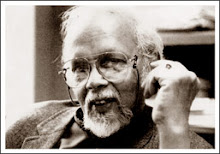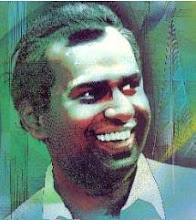Date: 25/01/2009
Source: Sunday Observer
Though dramas and stage plays are more or less confined to Colombo and Kandy, to a lesser extent, rarely a ballet is staged even in Colombo. It would not be surprising even if one were to question whether ballet really exists in Sri Lanka. The national Ballet Day was fittingly declared on the birthday of legendary dancer and theatre personality Chitrasena. Chitrasena was born on January 26, 1921.
 Although the Sri Lankan audience was used to watch dance drama, it was not familiar with ballet in its original form. Some watch ballet for its elegant costumes, attractive ballet dancers and their beautiful body movements. The dialogue the ballet intended to maintain with the audience is not the kind of superficial attraction some identified with the ballet.
Although the Sri Lankan audience was used to watch dance drama, it was not familiar with ballet in its original form. Some watch ballet for its elegant costumes, attractive ballet dancers and their beautiful body movements. The dialogue the ballet intended to maintain with the audience is not the kind of superficial attraction some identified with the ballet.
Primarily, ballet creates zest in the audience by musical scores and body movements although ballet is termed as dramatic manifestation. In fact, ballet conveys its message through music, elegant animation and stage craft. Basically it narrates a story.
Shown John Nervier and John Wiver, the pioneers of the modern ballet attempted to narrate a story through ballet in Royal Court. Subsequently this ballet (Ballet de action) evolved into a dramatic manifestation.
Contemporary ballet whether in Asia or in Europe, does not only narrate a story, but explores religious and philosophical ideas.
By now diverse forms of ballet such as plotless ballets (ballet only with music) have been developed. Originally ballet was developed in the West to depict Western myths and fairy tales with simple plots. Over time, it has evolved into a complex mode of dramatic expression assimilating diverse traditions of art. Thematically it has developed as simple drama plot of fairy tales to Shakespearean tragedies on violence, war and feminism. Many traditions of music such as Asian, African and Jazz enriched ballet repertoire of music and complex grammar of choreography.
The rudimentary form of ballet being staged in Sri Lanka was by the 'Group Modern', travelling troupe which came to Sri Lanka in 1935. A prominent member of the troupe was Rabindranath Tagore. The Sri Lankan performance was so successful that some of the inspired youth subsequently went to India to learn the craft.
From 1940's on, ballet in Sri Lanka had been developing parallel to the development of dance drama in India. Inspired by Indian dance drama on Sri Lankan ballet. Premakumara Epitawala's Sela Lihini Sandeshaya although it was more a musical than a ballet was of a different style.
Sri Lankan ballet carved out its distinctive indigenous flavour and physique with Chitrasen'a production of `Karadiya' in 1961 and `Nala Damayanthi' together with 'Karadiya' manifested a novel form with blend of indigenous, Indian and Western traditions. Chitrasena's subsequent productions such as Kinkini Kolama was (based on low country dancing) and "Shiva Ranga" born out of research into folk traditions such as Kolam.
In 'Shiva Ranga', though the story is based on an Indian legend, modern Western and Indian abstract ballet styles have been used instead of Indian dance drama style. Premakumara Epitawala, Shesha Palihakkara and Basil Mihiripenna have substantially contributed toward realising an indigenous tradition of ballet.
Ravibandu Vidyapathy's rendering of Shakespeare's Macbeth into a ballet was one of the important productions of ballet in contemporary Sri Lankan theatre. It is a full length ballet produced in Sri Lanka after a long time.
Perhaps, the selection of Macbeth itself is a daring act especially given the unprecedented success the play enjoyed over the centuries since its original production by Shakespeare himself. Macbeth is one of the few plays which have been translated into diverse media including into film. The grotesque details that are dramatically depicted in the film version or acted on the stage, unfortunately, cannot be adapted into a ballet , in their entirety, as the dramatic personae confront with inherent constrains in the medium of ballet.
The principle constraint in a ballet compared to conventional play or film, is that conversation and dialogue are not possible in a ballet. So the roles of conversation and striking dialogues have to be depicted in terms of carefully crafted pieces of choreography together with painstakingly practiced facial expressions. The emotional scores and dramatic situation are signalled by changing tempo of music score that should be heartbeat of a ballet.
Costume design also plays a vital role in a ballet as the costumes not merely introduce different dramatic persona but their distinct characteristics.
However, the drowning effect of music in the scene where Lady Macbeth knocks on the door was a marked shortcoming. It is hoped that this major lapse be corrected in the future production of the ballet. The knocking scene constitutes important developments in the plot.
Samanthi Vidyapathy has shown remarkable talents in portraying the seminal role of Lady Macbeth. Her facial expressions and even eye contacts were fine-tuned to suit the changing moods of the character. It should be mentioned here that her present portrayal is far an improvement compared to the Hecuba in Nirmana and may caused by slightly slimed figure. Her dramatic face dominated throughout the ballet.
Ravibandu's rendering of Macbeth into an oriental ballet should be judged against this technical backdrop and it should be unjust to consider it as complete adaptation of Macbeth into an oriental ballet.
On one hand, Macbeth the oriental ballet depicts only a selected act of the original play suitable to the medium and out of which an aesthetically satisfying pieces of choreographs can be made.
For instance, character which plays a prominent role in the original play, here plays a study material for post-graduate studies.




































No comments:
Post a Comment